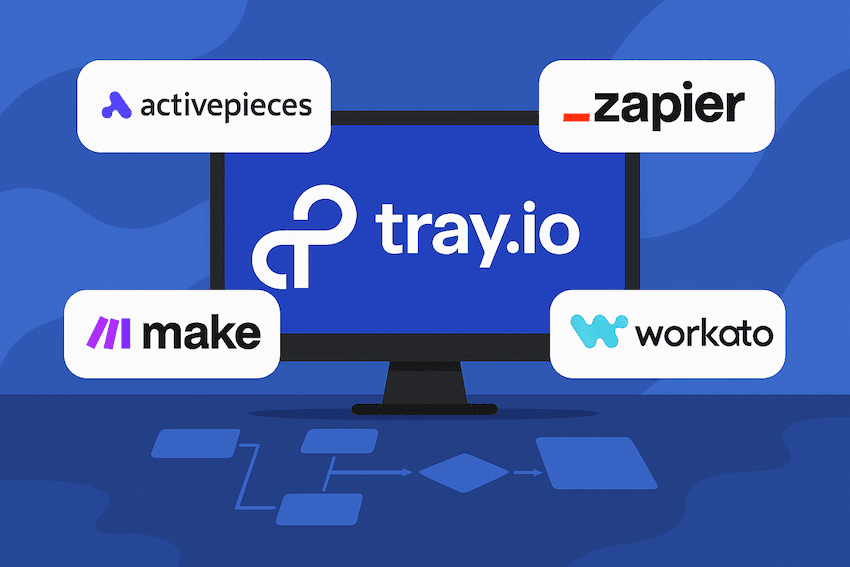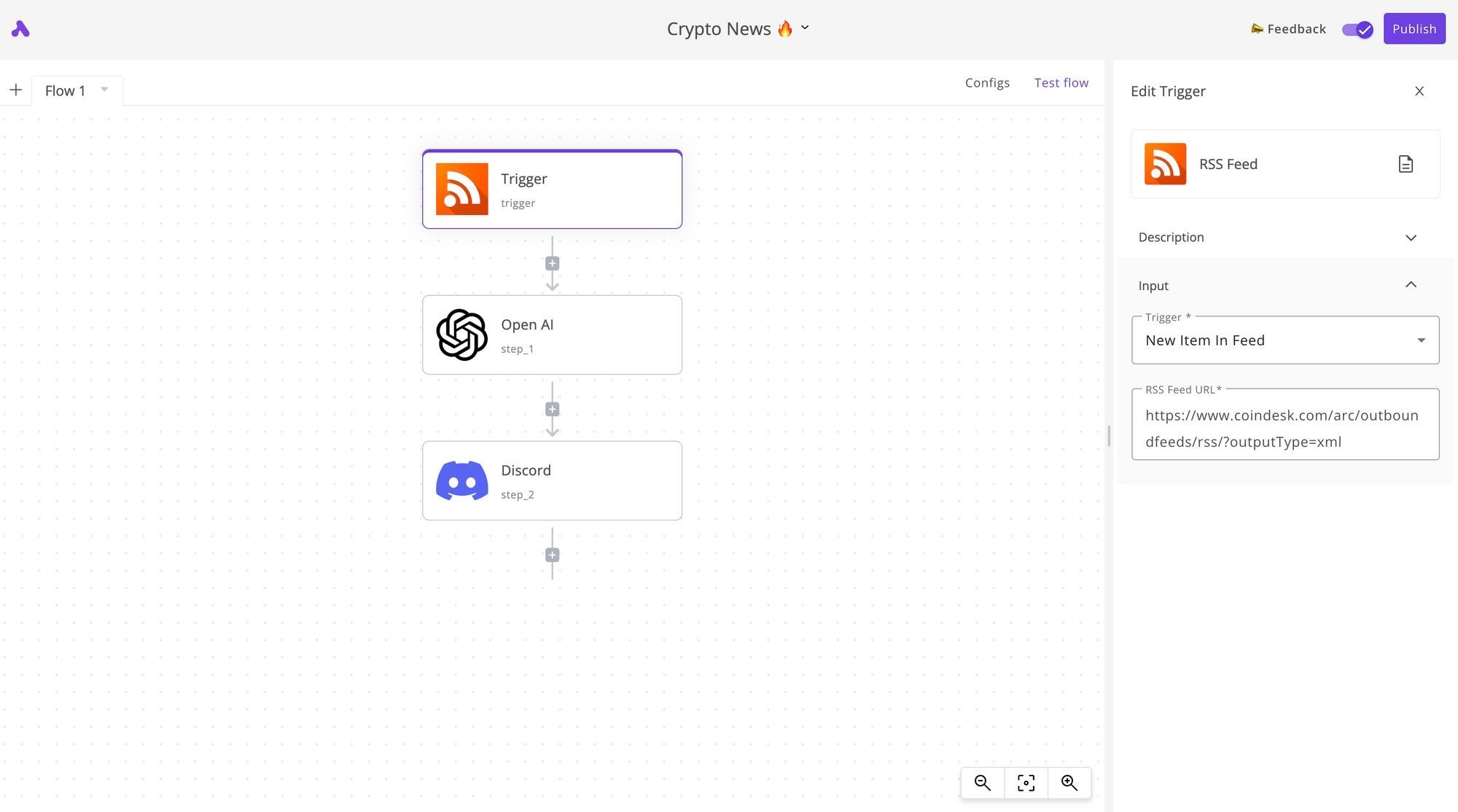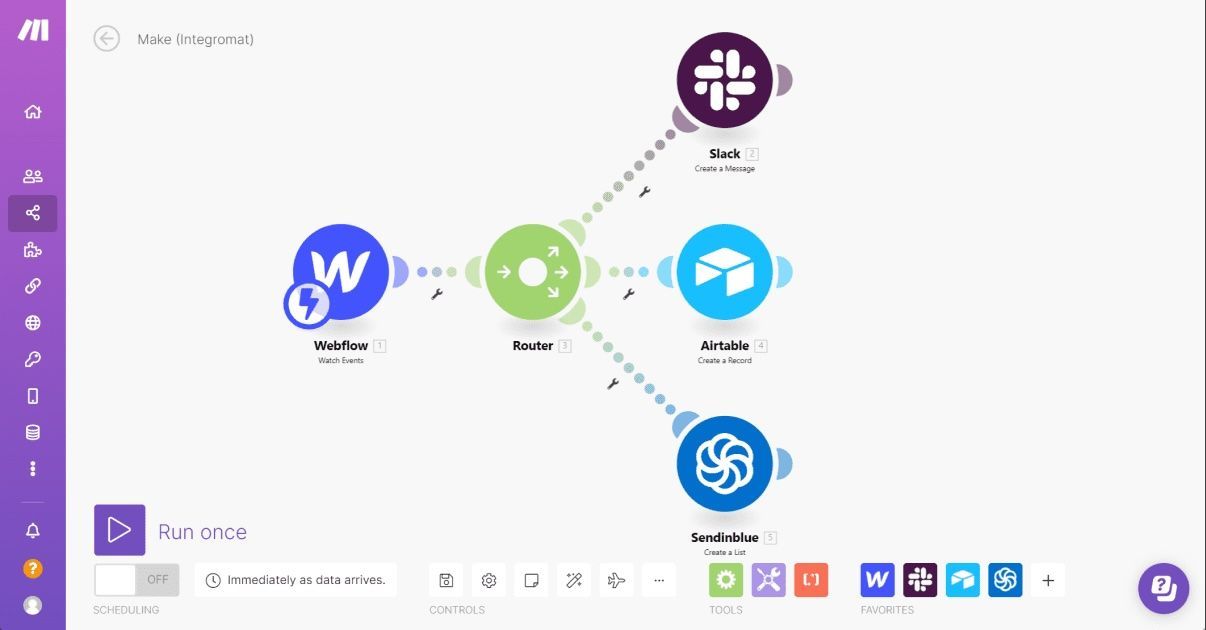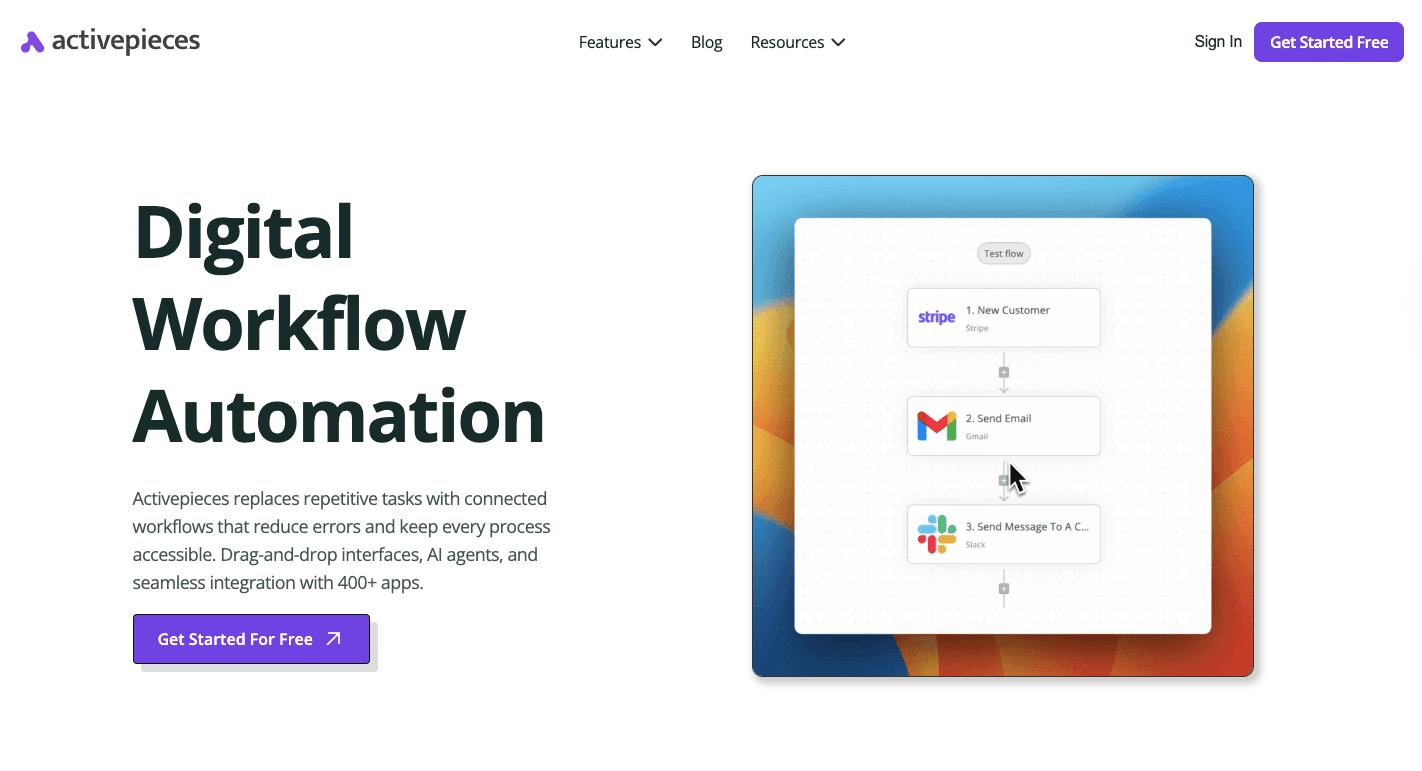4 Tray.io Competitors for Scalable Workflow Automation

Tray.io used to be the name everyone brought up when you wanted to connect your tools without writing code. It handled complex automations, moved data between CRMs and support platforms, and helped companies run cleaner workflows.
But once those setups got bigger, the cracks started to show. The pricing model felt unpredictable, and building or editing flows took longer than expected. Updates to pre-built connectors didn't always keep up with what users needed, too.
In this article, you'll learn about the best Tray.io competitors that help businesses automate faster and better.
Transform how your team works by signing up for Activepieces' free plan now!
What Is Tray.io?

Tray.io, now operating as Tray.ai, is an integration platform that helps you connect apps and automate processes across departments.
It combines "integration platform as a service (iPaaS)" and "Robotic process automation (RPA)" to give you one hub for building data connections, syncing systems, and managing existing workflows.
The platform includes two core products:
- Tray Platform allows you to create custom workflows and manage them from a single dashboard.
- Tray Embedded lets software vendors integrate Tray's automation engine directly into their own apps.
Typically, SaaS companies that want to offer integration capabilities without spending resources on custom development use Tray because of its embedded iPaaS option. Yet, it often requires technical expertise to master.
Features
Tray.io includes a wide selection of automation and data-handling features for enterprise use:
- Low-code visual workflow builder - Lets you design processes through a drag-and-drop interface with branching logic, loops, and data mapping.
- Pre-built connectors - Includes over 700 app connections such as Salesforce, Slack, Zendesk, and Google Workspace to help users integrate faster.
- Data transformation tools - Provide mapping and formatting options so data moves cleanly between systems.
- Merlin AI features - Add AI agents and assistants for building flows, writing logic, or documenting steps automatically.
- Tray Embedded - Offers a white-label embedded offering for organizations seeking to provide automation inside their own software products.
- Scalable architecture - Handles high-volume data processing through a serverless design that adjusts to enterprise load demands.
- Security and compliance - Includes SOC 2 and GDPR compliance, encryption, and field-level encryption for sensitive information.
Pricing
Tray.io doesn't disclose its pricing publicly.
Why Search for Tray.io Alternatives?
Let's explore its downside that pushes some users away to look for alternatives:
- Hidden pricing - Many users dislike having to contact sales for a quote instead of seeing clear costs.
- Difficult user interface - While the design looks good, building flows requires knowledge of JSON path and inline scripting. That creates a steep learning curve for non-technical users and small teams that expect a simpler setup.
- Complex logs and error management - Logs take time to load, and resolving issues often means switching between multiple screens.
- Outdated connectors - Several pre-built connectors lag behind updated APIs. When API endpoints change, you can't modify connectors themselves and must wait for Tray's team to fix them.
- Lack of documentation - Many notes are missing details for data integration and logic steps. For example, some transformation connectors have edge cases that you'll need to keep testing in order to get them right.
- Inconsistent support - Others said Tray Embedded doesn't get the same level of support as the other tools.
4 Best Tray.io Alternatives in 2025 (Ranked)
As you can guess by now, Tray.io has many alternatives and competitors, but we've ranked the best ones:
1. Activepieces

Activepieces is changing how automation feels and functions in the integration and automation space. With the drag-and-drop workflow builder, you can build complex automations in minutes.
Developers enjoy the freedom to write their own "pieces" in TypeScript, while everyday users can simply plug those pieces together and run them.
It further combines open-source transparency with an enterprise mindset, offering both data integration depth and AI-driven automation.
Companies usually use it to connect apps, handle approvals, and manage internal integrations. Since it's open source, its ecosystem keeps growing every week with new pieces created by the community.
Businesses of all sizes, from startups to global enterprises, choose Activepieces because it gives complete control and predictable costs through transparent pricing.
Features
These are the features that make Activepieces better:
- Open ecosystem - Every piece is open source and modifiable, which gives you freedom to extend functionality however you want.
- Visual workflow builder - Clean, drag-and-drop design makes it easy to create workflows and track each step.
- AI-ready automation - Built-in AI connectors and an SDK allow for the creation of custom agents and automated content flows.
- Custom integrations - Developers can build and publish new pieces quickly using a TypeScript framework with live testing.
- Self-hosted security - You can deploy the platform on your own servers to maintain privacy and compliance.
- Community growth - Over half of all available pieces come from the community, and contributions keep expanding the library.
- Human-in-loop options - Add approvals, delays, or manual checkpoints inside automations for real-world workflows.
Integrations
Activepieces currently supports 446 pre-built integrations, and that number keeps growing every day. The library is community-driven, meaning developers and users alike contribute new "pieces" that expand its coverage.

Some data integrations available include:
- OpenAI
- ElevenLabs
- Afforai
- Google Sheets
- Microsoft Excel 365
- ClickUp
- Slack
- AgentX
- ActiveCampaign
- WordPress
- Microsoft Dynamics CRM
- Microsoft Power BI
This constantly expanding network helps you automate across departments without waiting for vendor updates.
Use Cases
Activepieces fits into almost any team's workflow, regardless of size or skill level. You can use it to:
- Connect ads, forms, and CRMs for lead management
- Build custom AI agents for customer service or content creation
- Sync pipelines between tools like HubSpot, Salesforce, and Zoho
- Automate approvals, alerts, or report generation
Due to its flexibility, both startups and enterprises can use Activepieces to automate repetitive tasks and reduce friction between tools.
Pricing
Activepieces' Free plan offers 1,000 tasks monthly, AI access, and two active flows for individuals exploring automation. Moving up, the Plus plan costs $25 per month and fits small teams running unlimited tasks with more active flows and 500 AI credits.
For growing businesses, the Business plan costs $150 per month and adds 50 flows, 10 projects, and API access. Larger companies can opt for the Enterprise plan, which is available through a custom quote and includes dedicated support, higher resources, and extended security options.

There's also a Community Edition, completely free and self-hosted, for teams who want control over infrastructure and data.
Speak with our sales teams to see how Activepieces fits your business!
2. Zapier

Zapier is a familiar name in automation because it makes connecting apps simple enough for anyone to do. Using triggers and actions, it automates tasks like sending Slack messages, creating new leads in a CRM system, or saving files to cloud storage.
Each workflow, called a "Zap," follows the pattern of "when this happens, do that." For instance, when someone fills out a form, Zapier can instantly add their details to your marketing list or database. It's a cause-and-effect setup that helps you save time on repetitive jobs.
Although it's not meant for complex integration across enterprise environments, Zapier still delivers a comprehensive set of templates and automations that fit your specific business needs. And since it's web-based, you can build, edit, and track automation in one dashboard.
Features
Zapier includes features that make automation easier for beginners and larger teams:
- Triggers and actions - Each Zap starts with a trigger (an event) and performs an action in another app.
- Multi-step zaps - Connect several steps together to create advanced automation sequences across multiple tools.
- Filters and paths - Add conditions that control when actions happen.
- Webhooks - Allow custom integrations for apps that don't have native support.
- AI tools - Include AI Copilot and agents that help build automations through natural language.
- Zapier tables - Serve as custom databases to store and organize automation data.
- Zapier interfaces and canvas - Provide drag-and-drop tools to plan and design workflows visually.
- Enterprise-level security - Offers field-level encryption, user roles, and activity logs for enterprise-grade platforms.
- Template library - Includes pre-made Zaps so you can set up workflows quickly.
- Advanced admin controls - Help large teams manage accounts, connections, and permissions easily.
Pros
- Connects with over 8,000 cloud applications
- Offers templates for quick setup and deployment
- Handles complex workflows with conditional logic and multiple steps
Cons
- Some app connections offer limited actions compared to competitors
- Occasional sync delays for real-time workflows
- Managing large numbers of Zaps can be time-consuming
- Customer support can be slow to solve even simple problems
Pricing
Zapier's Free plan lets you create two-step Zaps and run 100 tasks per month. The Professional plan costs $29.99 per month and includes 750 tasks, multi-step Zaps, and access to premium apps.
Teams that need collaboration features can choose the Team plan, which costs $103.50 per month for 2,000 tasks, shared workspaces, and faster one-minute update times. Larger companies can request the Enterprise plan with custom pricing.
3. Make

Make, previously known as Integromat, is a visual-first automation solution that builds detailed workflow designs using a drag-and-drop canvas. Each process, called a "scenario," flows from a trigger to one or more actions. You can branch logic, route data, and manage entire processes from a single visual screen.
The setup enables users to follow how data moves between each module, which makes troubleshooting simpler. Every connected tool or function appears as a circular module that you can rearrange or expand at any time.
Organizations seeking a more advanced and visually-oriented approach to workflow automation often use Make. However, learning its interface can take a bit of time.
Features
Make gives you the following features:
- Visual scenario builder - Displays every workflow step visually, which makes it easy to follow how data moves across systems.
- Routers and branching logic - Add multiple outcome paths within a single workflow for detailed control.
- Advanced data handling - Lets you format, calculate, and transform data directly inside scenarios.
- API and webhook access - Allows custom integrations with internal tools or public APIs.
- Parallel processing - Speeds up execution by running multiple steps at once.
- Error handling - Identify and retry failed actions while providing detailed execution logs.
- Data stores - Work as built-in databases for holding and recalling information used in workflows.
- Security controls - Offer SSO, RBAC, and audit logs for safer automation management.
- Team collaboration - Includes permissions and templates for your teams working on shared automation projects.
Pros
- Visual builder that simplifies automation design
- Manages complex workflows with advanced routing and logic
- Includes enterprise-grade features for large organizations
Cons
- Steeper learning curve for new users
- Initial setup can be time-consuming
- Many users describe support as "nonexistent"
Pricing
Make's entry-level Free plan includes 1,000 monthly credits, access to the no-code visual workflow builder, and a 15-minute minimum interval between runs. Upgrading to the Core plan costs $10.59 per month and adds 10,000 credits, unlimited active scenarios, minute-level scheduling, and API access.
For teams that need more control, the Pro plan costs $18.82 per month, which offers priority execution, custom variables, and full-text execution log search. Collaboration-focused users often choose the Teams plan at $34.12 per month.
4. Workato

Workato is an integration and automation platform for businesses that need to connect multiple applications and streamline complex workflows. IT teams and business users use it to create automated workflows called "recipes," which link apps, sync data sources, and run actions when certain events happen.
These recipes follow a simple pattern: a trigger starts the process, and one or more actions follow, all built through a visual interface.
Besides that, you can connect almost any app since Workato provides internal integrations and advanced custom integrations. It also includes an embedded offering that provides different deployment options for vendors that want to offer automation capabilities within their own products.
For companies focused on business growth, the platform scales automatically as processes expand. In addition, it offers embedded iPaaS capabilities for software providers that want integration built directly into their services.
Features
Workato combines features for automation depth and enterprise readiness in one unified platform.
- Recipes - Predefined automations that connect apps through triggers and actions.
- Low-code interface - Allows both technical and non-technical users to build automations with minimal coding.
- Extensive connectors - Offers 1,000 pre-built connectors and SDK support for custom integrations.
- Data transformation - Clean, reformat, and manipulate data with ETL and ELT capabilities.
- Real-time sync - Keeps systems updated instantly as triggers fire.
- AI-powered automation - Uses RecipeIQ and Workato Genie for suggestions and predictive automation setup.
- Workbot - Lets you run automations directly from Slack or Microsoft Teams.
- API management - Includes tools to publish and govern APIs and expose recipe actions as API endpoints.
- Collaborative governance - Offers versioning, audit logs, and RBAC for full visibility and compliance.
- On-Prem connectivity - Integrates securely with on-site databases or apps through an on-prem agent.
Pros
- Excellent for automating complex workflows across enterprise systems
- Large connector library for cloud and on-premise apps
- Intuitive low-code builder that suits both IT and business users
Cons
- The pricing is hidden and very high
- Requires time and experience to master advanced features
- Debugging large recipes can be challenging
- Some customization requests rely on Workato's development roadmap
Pricing
Workato doesn't share its pricing publicly, since plans are customized for each enterprise client.
Scale Beyond Tray.io Limitations With Activepieces

Automation shouldn't feel restricted, and Activepieces breaks past the limitations of closed, high-cost systems like Tray.io by offering an open-source, AI-powered platform that grows with you. For teams just starting with automation, it's simple enough to use.
Other than that, you get an impressive library of integrations with 446 pieces. This growing library helps you connect tools faster and adapt existing workflows. It also supports data integration across CRMs, analytics platforms, and AI tools, so you can unify your information streams in one place.
Beyond features, Activepieces has transparent pricing and dedicated support. In short, it's a complete integration platform that puts control, customization, and scalability directly in your hands.
Give Activepieces a try and see why it's the favorite among Tray.io alternatives!
FAQs About Tray.io Competitors
What are the best Tray.io alternatives for business users in 2025?
The best Tray.io alternatives for business users in 2025 are Activepieces, Make, Zapier, and Workato.
Is Activepieces better than Tray.io for automation?
Yes. Activepieces offers faster setup and open-source access, unlike Tray.ai's closed system and custom quote pricing. It also provides more deployment freedom, AI-ready tools, and community-driven innovation.
How does Zapier compare to Tray.ai in terms of pricing model?
Zapier's task-based pricing model is simpler but can get costly with high-volume use. Tray.ai's usage-based pricing is more complex and lacks a free tier, which limits accessibility for smaller businesses or testing automation at scale.
Which Tray.ai alternative is best for startups or small businesses?
Activepieces is the best option for startups and small businesses since it offers flat-rate plans, an open-source ecosystem, and a better AI focus.
What's Tray Embedded?
Tray Embedded is part of Tray.ai's platform, which is purpose-built for the embedded integrations market. It lets software vendors embed Tray's automation features directly into their own apps.


